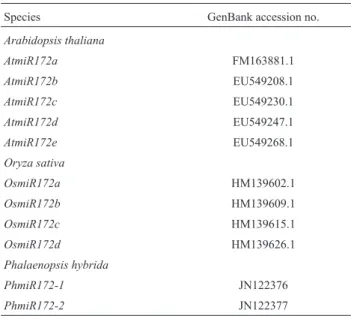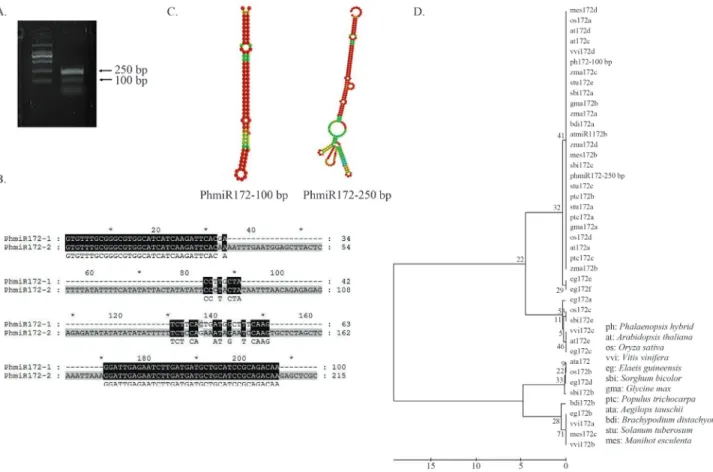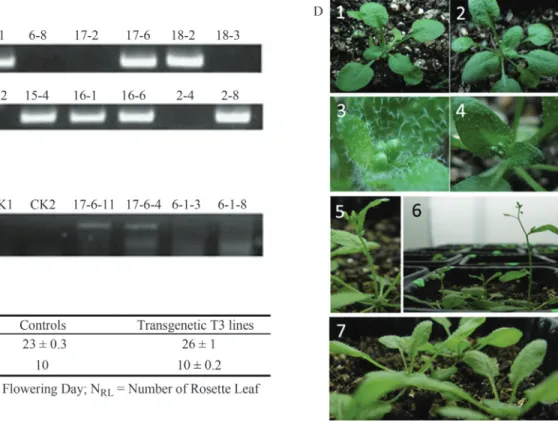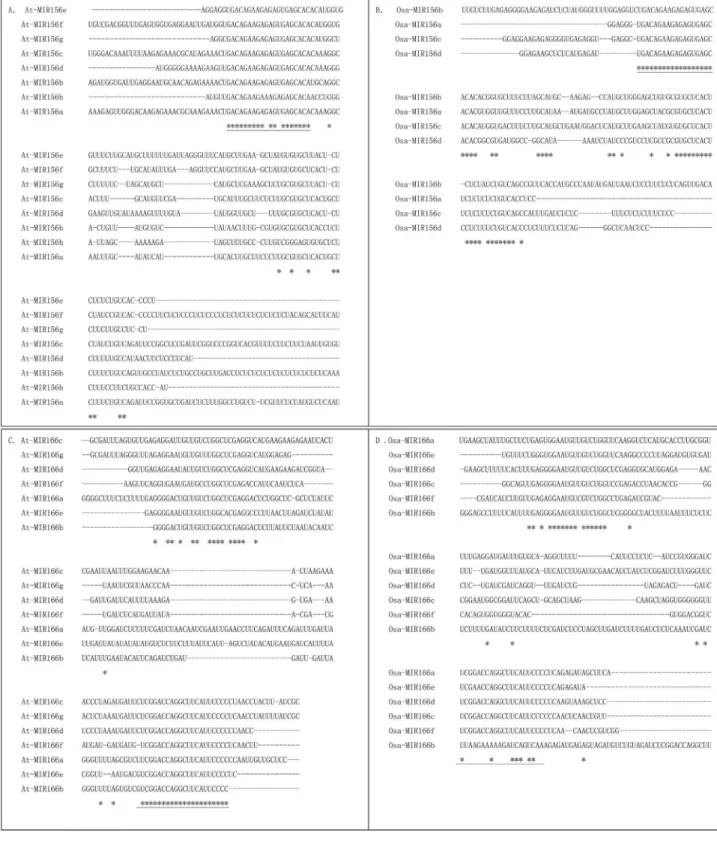An effective homologous cloning method for isolating novel miR172s from
Phalaenopsis hybrida
Ying Ying Han
1,2,*, Qin Hua Yan
1,*and Feng Ming
1 1State Key Laboratory of Genetic Engineering, Institute of Genetics, Institute of Plant Biology,
School of Life Sciences, Fudan University, Shanghai, China.
2
Center of Systematic Biomedical Research, College of Medical Appliance and Food Sciences,
University of Shanghai for Science and Technology, Shanghai, China.
Abstract
MiR172 is an important microRNA that regulates floral development in various plants and downregulates AP2 family members to relieve the stress on floral determinacy, leading to phase transition from vegetative to reproductive growth. In this work, PCR with primers designed based on the ricemiR172 sequence was used to isolate two miR172-like transcripts from Phalaenopsis hybrida (PhmiR172-1 and PhmiR172-2) that were very similar to Oryza miR172d and Arabidopsis miR172b. RT-PCR indicated that the levels of these two transcripts were negatively corre-lated with the level of thePhalaenopsis AP2 (PhAP2) gene in stem, root, pedicel and sepal, and that both were co-expressed withPhAP2 in young buds. Overproduction of PhmiR172-2 in Arabidopsis led to early flowering. The homologous cloning method used to isolate thePhalaenopsis miR172-like transcripts can be used to isolate miRNAs from other species. ThesePhmiR172 transcripts may be used to accelerate the flowering of orchids.
Key words:homologous cloning,miR172, miRNA,Phalaenopsis, sequence conservation.
Received: April 14, 2013; Accepted: August 16, 2013.
Introduction
MicroRNAs, non-coding RNAs 21-23 bp in size, are critical developmental factors in animals and plants (Bartel, 2004) that were originally thought to transcriptionally down-regulate target genes without reducing the amount of corresponding target RNA (Leeet al., 1993). Later studies showed that miRNAs can also degrade mRNA directly (Llaveet al., 2002; Yektaet al., 2004; Allenet al., 2005; Baggaet al., 2005). MicroRNAs are a key factor in main-taining the homeostasis of some transcriptional control pathways and make gene expression more precise (Achard et al., 2004; Chiouet al., 2006).
In plants, many miRNAs are involved in the precise control of flowering time because of its roles in sexual re-production and maintenance of the species. Many miRNAs are involved in maintaining phase transition,e.g.,miR156 targets SPLs (squamosa promoter binding protein-like) (Schwab et al., 2005), miR159(phytohormone pathway) directs the cleavage of MYB33 transcripts, resulting in the repression ofLEAFY (Achard et al., 2004), and miR172 promotes floral transition by repressing the expression of AP2 members (Park et al., 2002; Aukerman and Sakai 2003).
MicroR172 participates in the photoperiod pathway and is positively regulated by GI (GIGANTEA) in an age-dependent rather than rhythmic manner (Jung et al., 2007).MiR156regulates SPL9 and SPL10 that control the expression ofmiR172by directly promoting the transcrip-tion ofmiR172b(Wuet al., 2009). In addition,miR172can affect floral organ identity (Zhaoet al., 2007; Zhuet al., 2009; Zhu and Helliwell, 2011), possibly through a func-tion of AP2, an A-class gene that specifies perianth organs (Parcyet al., 1998; Wollmannet al., 2010).
The positive effect of miR172 on the induction of flowering makes it a potential target gene for commercial flowering plants. However,miR172has not been isolated from important ornamental plants because precursor se-quences are not as conserved as protein coding genes (Griffiths-Joneset al., 2006), althoughmiR172transcripts have been identified in many kinds of plants, including to-bacco (Kasaiet al., 2010), maize (Chucket al., 2007), ap-ples (Gleaveet al., 2010), morning glory (Glazinskaet al., 2009) and potato (Martinet al., 2009; Hwanget al., 2011).
Phalaenopsisis an important horticultural plant with a long vegetative period of at least 15 months. These plants flower only under strict temperature, humidity and photo-period conditions, which makes them more expensive. In an attempt to shorten the flowering time ofPhalaenopsis, two novel miR172 transcripts of Phalaenopsis hybrida were isolated by RT-PCR and characterized. ThesemiR172 www.sbg.org.br
Send correspondence to Feng Ming. Genetics Building, Room 5010, Fudan University, 220 Handan Road, 200433 Shanghai, China. E-mail: fming@fudan.edu.cn.
*These authors contributed equally to this work.
transcripts should be useful in genetic engineering of the phase transition inPhalaenopsisspecies. The homologous cloning method described here can also be used to isolate other pre-miRNAs from non-model organisms.
Materials and Methods
Plant material
Phalaenopsis hybrida(~20 months old) was grown in a greenhouse under standard conditions (16/8 h light/dark cycle at 25-28 °C).
Amplification ofPhalaenopsis miR172sequences Genomic DNA extracted from leaf tissue according to the method of Dellaportaet al.(1983) was used as a tem-plate for PCR amplification under the following condi-tions: 5 min at 94 °C for initial denaturation, followed by 30 cycles of 30 s at 94 °C, 60 s at 55 °C and 90 s at 72 °C with a 10 min extension at 72 °C. The primers used for PCR were designed against conservedmiR172sequences (enzyme re-striction sites and protective bases are underlined): For-ward - 5’-GCCAAGCTTGTGTTTGCGGGCGTGGCA TCATCAAGATTC-3’ and Reverse - 5’-GCGAGCTCTT GTCTGCGGATGCAGCATCATCAAGAT-3’.
Sequencing and analysis ofPhalaenopsis miR172s
The PCR products were cloned into pGEM-T vectors (Promega, USA) for identification and sequencing. The secondary structures of identified miRNA precursors were predicted with the software RNA fold. The miR172 se-quences from Aegilops tauschii, Arabidopsis thaliana, Brachypodium distachyon, Elaeis guineensis, Glycine max, Manihot esculenta, Oryza sativa, Phalaenopsis hybrida, Populus trichocarpa, Solanum tuberosum, Sorghum bicolor andVitis viniferawere aligned using CLUSTAL X soft-ware (Thompsonet al., 1994). Table 1 shows the name and GenBank number of the miR172s from O. sativa (OsmiR172) and A. thaliana. Phylogenetic analysis was done with Mega5.0 software.
Semi-quantitative RT-PCR
Total RNA was extracted from root, stem, leaf, pedicel, bud, sepal, petal, labellum and pistil ofP. hybrida using RNAiso Plus (Takara). After treatment with DNase
I, 1mg of total RNA was used to synthesize first strand
cDNA using a PrimerScript reverse transcriptase kit (Takara). Sequence alignment was used to design a pair of primers to amplify the Phalaenopsis AP2 gene. The primer sequences and PCR conditions used are listed in Table 2. All of the reactions were initiated with a 5 min de-naturation at 94 °C.
TransgenicArabidopsis
The newly identified PhmiR172 sequences were cloned into the pHB vector (Renet al., 2005) for constitu-tive expression, and new blossomed flowers ofArabidopsis were infected with Agrobacterium strain EHA105-35S::PhmiR172. The seeds of transgenic plants were screened in hygromycin (0.5 mg/mL). Vegetative days and rosette leaf number before flowering were counted in wild-type and T3plants. The experiment was carried out with three independent occasions with n = 3/group each time. RNA was extracted with RNAiso Plus (Takara) from T3plants, followed by treatment with DNase I and cDNA synthesis. The primers and PCR conditions for the Phalaenopsisgenes and the internal control are described in Table 1.
Table 1- Accession numbers ofmiR172s fromA. thaliana(AtmiR172),O. sativa(OsmiR172), andP. hybrida.
Species GenBank accession no.
Arabidopsis thaliana AtmiR172a FM163881.1 AtmiR172b EU549208.1 AtmiR172c EU549230.1 AtmiR172d EU549247.1 AtmiR172e EU549268.1 Oryza sativa OsmiR172a HM139602.1 OsmiR172b HM139609.1 OsmiR172c HM139615.1 OsmiR172d HM139626.1 Phalaenopsis hybrida PhmiR172-1 JN122376 PhmiR172-2 JN122377
Table 2- PCR primers and conditions used in this work.
Target gene Primer sequence (5’ to 3’) PCR conditions
ACTIN Forward: TGGAACTGCCAAGACG
Reverse: GCAGCGAAGATTCAAAA
30 s 94 °C, 30 s 55 °C, 30 s 72 °C; 28 cycles
PhmiR172 Forward: GTGTTTGCGGGCGTGGC ATCATCAAGATTC
Reverse: TTGTCTGCGGATGCAGC ATCATCAAGAT
30 s 94 °C, 30 s 58 °C, 30 s 72 °C; 30 cycles
PhAP2 Forward: AAGTTCACAGTATAGAGG
Reverse: GCATGCCTGCAGGTCGAC
Results
Isolation and sequence analysis ofPhalaenopsis
miR172
Since Phalaenopsis is monocotyledonous primers were designed based on the sequences of ricemiR172s. The stem sequences of ricemiR172s were aligned (Figure 1) and the core regions of miRNA and miRNA* were found to be conserved, which facilitated the PCR cloning.
Two novel Phalaenopsis miR172-like (PhmiR172) sequences of different lengths were isolated by PCR using genomic DNA as the template (Figure 2A). Random ampli-fication resulted in fragments of different lengths: the 100-bp fragment was referred to asPhmiR172-1and the 250-bp fragment asPhmiR172-2. Sequence analysis was undertaken before characterizing the function of these frag-ments by expression analysis and in transgenic plants. The predicted secondary structures of the twoPhmiR172 pre-cursors had a unique stem-loop region (Figure 2C) and shared a number of identical nucleotides, in addition to the region matching the primers (Figure 2B).
The stem loop sequences ofmiR172from 12 species, along withPhmiR172-1andPhmiR172-2,were subjected to phylogenetic analysis (Figure 2D). The regions matching the primer sequences were removed from thePhalaenopsis miR172s to prevent false clustering with OsmiR172. The two PhmiR172s were closely related to the miR172s of most other species and formed a major highly-related clus-ter that included most of themiR172s studied. Although the main cluster includedmiR172sfrom all of the species, sev-eralmiR172s from seven species diverged from the main branch, including Oryza 172b/c, Vitis miR172a/b/c and others (Figure 2D).
Expression ofPhmiR172andPhalaenopsis AP2
Semi-quantitative RT-PCR was used to examine the expression pattern ofmiR172and its potential target, the AP2family gene, inP. hybridatissues. The same primers were used to amplifyPhmiR172-1 and PhmiR172-2 be-cause of the short length ofPhmiR172-1. RT-PCR indi-cated that the transcription levels ofPhmiR172s andPhAP2 were complementary in some tissues, such as root, stem, leaf and petal, which implied thatPhmiR172s might affect the transcription of AP2 (Figure 3A). Both versions of miR172were mainly expressed in root, stem, pedicel and bud, whilePhAP2transcripts were limited to leaf, pedicel, bud and petal.MiR172was expressed at a relatively high level in root and stem, and noAP2mRNA was detected in these tissues.AP2mRNA was expressed in leaf and petal, where nomiR172was detected. The detected transcript of PhAP2was cloned and sequenced, but was only recovered as a partial mRNA (107 bp; too short to be deposited in GenBank). Phylogenetic analysis was done to confirm its identity (Figure 3B).
However,PhmiR172andPhAP2transcripts were de-tected in early flower structures, such as pedicels and buds (Figure 3A), which indicated a mode of dynamic regulation betweenPhmiR172and its target during early flowering. The levels ofPhmiR172-1andPhmiR172-2were not iden-tical in the same tissues. For example, only the precursor of PhmiR172-1was detected in roots and buds, whereas both PhmiR172s were detected at a higher level in the stem and pedicel (Figure 3A).
Overexpression ofPhmiR172inArabidopsis
promotes flowering
PhmiR172-2showed greater sequence similarity with miR172s from other species than didPhmiR172-1. Based
Figure 2- Cloning and sequence analysis of Phalaenopsis miR172s. (A) PCR amplification of novel PhmiR172 sequences. (B) Sequence alignment of PhmiR172-1 and PhmiR172-2. Dark regions represent identical nucleotides. The primer sequences are indicated under the alignment. *Conserved nucleo-tides. (C) Secondary structures of precursor PhmiR172s, both with unique stem-loop structures. The red color indicated the higher possibility of base-pairing.When the color is inclined to be red, the possibility of base-paring is becoming higher. (D) Phylogenetic tree ofmiR172precursors from
Arabidopsis,OryzaandPhalaenopsisconstructed using the maximum evolution method. The horizontal scale at the bottom was the scale for substitution rate (%). The numbers at the nodes refer to the bootstrap value (maximum is 100), which implied the reliability of existing clades in the tree. The number in each clade represented the percentage of success for constructing the existing clade. The system has performed 1000 replicates to construct the phylogeny.
on this finding, we inserted thePhmiR172-2 transcript into A. thaliana plants to obtain homozygous plants overex-pressingPhmiR172-2(T3). We identified the hygromycin tolerance gene (hpt; hygromycin phosphotransferase) that served as a marker for the vector sequences that remained in transgenic T2plants along with the 250-bpPhmiR172-2 sequence (Figure 4A). Hpt-positive seeds from T2and T3 seeds were analysed for gene expression and phenotype. The T3plants expressed transcripts that were absent in con-trol wild-type (WT) plants, although the sizes of these tran-scripts were not uniform (Figure 4B).
As expected, the T3plants had an early flowering phe-notype (p = 0.02), flowering on average three days earlier than the controls (Figure 4C),i.e., the 23rdday of growth (counting from seed germination, Figure 4D 2) compared to the 26thday for WT plants(Figure 4D 7). There was no difference in leaf number between WT and transgenic plants when they blossomed (p = 0.4) (Figure 4C). The phe-notypes of WT and transgenic plants are shown in Figu-re 4D.
Discussion
MiR172is an miRNA that regulates flower develop-ment by targeting theTOE1andAP2family genes
(Auker-man and Sakai, 2003). These genes belong to the A family in the ABC flowering model proposed by Bowmanet al. (1991) and control early floral whorls. Overexpression of miR172induced early flowering and changed the floral or-gan identity. In Arabidopsis, pAP2::AP2m3 transgenic lines, which escape repression bymiR172, have a dramatic phenotype involving indeterminate floral tissues (Chen, 2004), which suggests the importance ofmiR172in regulat-ing the floral meristem via targetregulat-ing ofAP2.Arabidopsis miR172defines the boundary of B family gene expression (Chen, 2004) and restricts AP2 expression to the stamen to prevent stamen-petal transformation (normally associated with AP2 overexpression) (Wollmannet al., 2010).
Phalaenopsis is an economically important flower with a long flowering period that leads to high prices. To accelerate the flowering period ofPhalaenopsisby genetic engineering, we isolated two forms of miR172 from P. hybrida. We had previously failed to isolatePhalaenopsis miR172using the rapid identification of 5’ and 3’ ends of cDNA. However, since this miRNA is conserved among various species and forms a stem-loop structure we de-duced that miRNA* should also show some degree of con-servation. For this, rice miR172s were compared and primers were designed based on the sequences of con-served regions (Figure 1), particularly the concon-served
cleotides at the 3’ ends of both primers. RT-PCR using genomic DNA as the template yielded twoPhalaenopsis miR172 precursors. This method can be used to isolate other homologous miRNAs because the stem-loop se-quences of most miRNAs are conserved between Arabidopsisand rice miRNAs* (Figure 5).
PhmiR172-2showed higher sequence identity with miR172fromArabidopsisand rice than didPhmiR172-1. Phylogenetic analysis indicated thatPhmiR172-2formed a cluster with ricemiR172dandArabidopsis miR172b. The shared conserved sequence amongmiR172s was initially identified inPhalaenopsis miR172.PhmiR172-1diverged
Figure 5- Sequence alignment ofArabidopsisandOryzamiRNAs. *Conserved nucleotides. The core sequences of the miRNAs are underlined. At:
considerably from the main branch of plant miR172s, which suggested that it may be specific toP. hybrida.The predicted secondary mRNA structure of thePhalaenopsis miR172precursor included a unique stem-loop that proba-bly contributed to the relative stability of this mRNA in cells and facilitated its recognition for subsequent splicing.
The expression of Phalaenopsis miR172s and their target,PhAP2, was investigated. The primers for PhAP2 were designed based on conserved sequences such that the overall level ofPhAP2expression should represent or in-clude that of several members of the AP2 family. As ex-pected, semi-quantitative RT-PCR indicated that the level of PhmiR172s precursors was negatively correlated with that of the target genes in tissues such as root, stem, leaf and petal. Enhanced expression ofmiR172s may suppress the
levels ofPhalaenopsisAP2 family members, suggesting an antagonistic relationship between miR172 and the AP2 family inPhalaenopsis species. In this regard 5’ RACE PCR could be useful for demonstrating target cleavage. Real-time PCR would provide better quantification of the expression, but for PhmiR172-1 and PhmiR172-2 com-bined.
Intriguingly, the expression levels of the two PhmiR172s were not identical. The 250-bp transcript was detected mainly in stem and pedicel, while the 100-bp tran-script was detected mainly in bud and root. This divergent expression suggested different functions and regulatory mechanisms for the two miRNAs, a conclusion consistent with the sequence divergence between these two members, as indicated by the phylogenetic analysis.
The over-expression ofPhmiR172inArabidopsiscan lead to early flowering and provides evidence for the con-served function ofmiR172among plants. Further exoge-nous expression of PhmiR172 should be done using Phalaenopsis as the host. In previous work, the over-expression ofmiR172led to altered floral organ identity in Arabidopsisand rice (Zhaoet al., 2007; Zhuet al., 2009); this phenomenon was not observed here.
In conclusion, the cloning and functional verification of PhmiR172 will provide a better understanding of the control of flowering time inPhalaenopsis. In addition, the newly identifiedPhalaenopsis miR172s can be used in ge-netic engineering to accelerate the flowering time of this or-chid. This homologous cloning method can be applied to miRNAs from a wide variety of plant species.
Acknowledgments
This work was supported by grants from the National Natural Science Foundation of China (grant no. 30900782), the Ministry of Agriculture of China (grant no. 2008ZX08009-001-008) and the Natural Science Founda-tion of Shanghai (grant no. 12ZR1402300), and the Chi-nese Post-Doctoral Foundation (grant no. 20080440580).
References
Achard P, Herr A, Baulcombe DC and Harberd NP (2004) Modu-lation of floral development by a gibberellin-regulated microRNA. Development 131:3357-3365.
Allen E, Xie Z, Gustafson AM and Carrington JC (2005) microRNA-directed phasing during trans-acting siRNA biogenesis in plants. Cell 121:207-221.
Aukerman MJ and Sakai H (2003) Regulation of flowering time and floral organ identity by a microRNA and its APETALA2-like target genes. Plant Cell 15:2730-2741. Bagga S, Bracht J, Hunter S, Massirer K, Holtz J, Eachus R and
Pasquinelli AE (2005) Regulation by let-7 and lin-4 miRNAs results in target mRNA degradation. Cell 122:553-563.
Bartel DP (2004) MicroRNAs: Genomics, biogenesis, mecha-nism, and function. Cell 116:281-297.
Bowman JL, Smyth DR and Meyerowitz EM (1991) The ABC model of flower development: Then and now. Development 139:4095-4098.
Chen X (2004) A microRNA as a translational repressor of APETALA2 in Arabidopsisflower development. Science 303:2022-2025.
Chiou TJ, Aung K, Lin SI, Wu CC, Chiang SF and Su CL (2006) Regulation of phosphate homeostasis by microRNA in
Arabidopsis. Plant Cell 18:412-421.
Chuck G, Meeley R, Irish E, Sakai H and Hake S (2007) The maize tasselseed4 microRNA controls sex determination and meristem cell fate by targeting Tasselseed6/indetermi-nate spikelet1. Nat Genet 39:1517-1521.
Dellaporta SL, Wood J and Hicks JB (1983) A plant DNA mini-preparation: version II. Plant Mol Biol Rep 1:19-21.
Glazinska P, Zienkiewicz A, Wojciechowski W and Kopcewicz J (2009) The putative miR172 target gene InAPETALA2-like is involved in the photoperiodic flower induction of
Ipomoea nil. J Plant Physiol 166:1801-1813.
Gleave AP, Ampomah-Dwamena C, Berthold S, Dejnoprat S, Karunairetnam S, Nain B, Wang Y-Y, Crowhurst RN and MacDiarmid RM (2010) Identification and characterization of primary microRNAs from apple (Malus domesticacv. Royal Gala) expressed sequence tags. Tree Genet Genomics 4:343-358.
Griffiths-Jones S, Grocock RJ, van Dongen S, Bateman A and Enright AJ (2006) miRBase: MicroRNA sequences, targets and gene nomenclature. Nucleic Acids Res 34:D140-144. Hwang EW, Shin SJ, Park SC, Jeong MJ and Kwon HB (2011)
Identification of miR172 family members and their putative targets responding to drought stress inSolanum tuberosum. Genes Genom 33:105-110.
Jung JH, Seo YH, Seo PJ, Reyes JL, Yun J, Chua NH and Park CM (2007) The GIGANTEA-regulated microRNA172 me-diates photoperiodic flowering independent of CONSTANS inArabidopsis. Plant Cell 19:2736-2748.
Kasai A, Kanehira A and Harada T (2010) miR172 can move long distances inNicotiana benthamiana. Open Plant Sci J 4:1-6. Lee RC, Feinbaum RL and Ambros V (1993) TheC. elegans
heterochronic gene lin-4 encodes small RNAs with anti-sense complementarity to lin-14. Cell 75:843-854. Llave C, Xie Z, Kasschau KD and Carrington JC (2002) Cleavage
of scarecrow-like mRNA targets directed by a class of
ArabidopsismiRNA. Science 297:2053-2056.
Martin A, Adam H, Diaz-Mendoza M, Zurczak M, Gonzalez-Schain ND and Suarez-Lopez P (2009) Graft-transmissible induction of potato tuberization by the microRNA miR172. Development 136:2873-2881.
Parcy F, Nilsson O, Busch MA, Lee I and Weigel D (1998) A ge-netic framework for floral patterning. Nature 395:561-566. Park W, Li J, Song R, Messing J and Chen X (2002) CARPEL
FACTORY, a Dicer homolog, and HEN1, a novel protein, act in microRNA metabolism inArabidopsis thaliana.Curr Biol 12:1484-1495.
Ren ZH, Gao JP, Li LG, Cai XL, Huang W, Chao DY, Zhu MZ, Wang ZY, Luan S and Lin HX (2005) A rice quantitative trait locus for salt tolerance encodes a sodium transporter. Nat Genet 37:1141-1146.
Schwab R, Palatnik JF, Riester M, Schommer C, Schmid M and Weigel D (2005) Specific effects of microRNAs on the plant transcriptome. Dev Cell 8:517-527.
Thompson JD, Higgins DG and Gibson TJ (1994) CLUSTAL W: Improving the sensitivity of progressive multiple sequence alignment through sequence weighting, position-specific gap penalties and weight matrix choice. Nucleic Acids Res 22:4673-4680.
Wollmann H, Mica E, Todesco M, Long JA and Weigel D (2010) On reconciling the interactions between APETALA2, miR172 and AGAMOUS with the ABC model of flower de-velopment. Development 137:3633-3642.
Yekta S, Shih IH and Bartel DP (2004) MicroRNA-directed cleavage of HOXB8 mRNA. Science 304:594-596. Zhao L, Kim Y, Dinh TT and Chen X (2007) miR172 regulates
stem cell fate and defines the inner boundary of APETALA3 and PISTILLATA expression domain inArabidopsisfloral meristems. Plant J 51:840-849.
Zhu QH and Helliwell CA (2011) Regulation of flowering time and floral patterning by miR172. J Exp Bot 62:487-495. Zhu QH, Upadhyaya NM, Gubler F and Helliwell CA (2009)
Over-expression of miR172 causes loss of spikelet determi-nacy and floral organ abnormalities in rice (Oryza sativa). BMC Plant Biol 9:e149.
Internet Resources
RNA structure analysis software, RNA fold,
http://bibiserv.techfak.uni-bielefeld.de/rnafold/submis-sion.html (December 16, 2012).
Mega5.0 software, http://www.megasoftware.net/faq.php (Janu-ary 7, 2012).
Associate Editor: Marcia Pinheiro Margis




